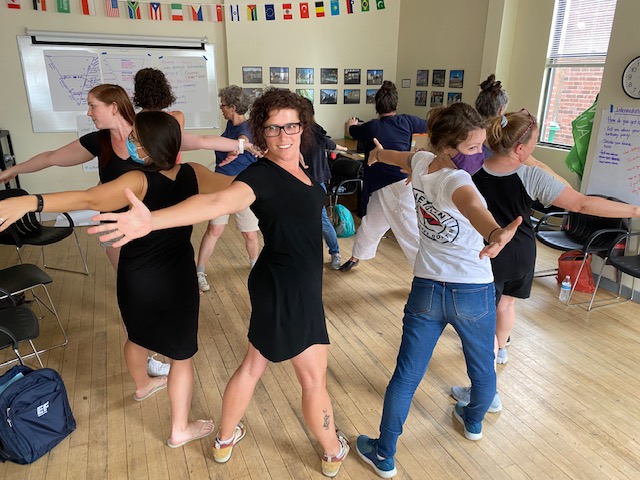
As the New Year begins, many of us have decided to get our toes wet and see how it feels to use more target language in class. Maybe some of us want to start the year by creating an immersive environment. Either of these scenarios may be met with varying levels of excitement, skepticism or responses from the students. Some classes jump right in and go for it, while others are a bit more reticent. For those of us who have ever experienced class pushback, or just simple refusal by students to try and understand, this is for you.
Things to keep in mind
When we begin using more target language in class, students will be excited, interested and possibly, uncomfortable. This is normal. Do not let this scare you! Target language immersion is new to them and may be new to us as teachers as well. As we ask them to move in or engage with the target language, it can be frustrating and nerve wracking. That is ok. Be assured in the knowledge that the more we implement new strategies, set expectations and then maintain them, student discomfort will be replaced with language usage and fearlessness.
As we think about a typical school day, in what other situations are they being asked to move, use their bodies, actively think and engage or step out of their comfort zone? Classes such as PE, music, or theater might be comparable, however many students do not have a precedent for this kind of behavior or learning in an ‘academic’ class. As teachers, our goal, and challenge, is to help them feel comfortable in a new, out of the box situation.
Things that will help
Movement! Encouraging students to use their body takes them out of their heads, lowers their affective filter, and moves them into a more relaxed space where they can let down their guard and take risks.
Building community. How well do they know each other? It is vital for them to build relationships: between one another and with you. Be curious! Model how to learn things about each other. Laugh and have fun together.
Games. Try out a wide variety of games. See which ones generate a buzz and capture attention and which ones don’t. Stick with it. Simply because one game doesn’t work, doesn’t mean that another one won’t, and what works for one class may not work for another. Keep experimenting! Start with low risk games that will encourage silliness and letting go, then build to more complex games once the stage is set. Keep in mind that you want to maintain target language even while playing games. This can be effectively achieved by modeling and repeating while having fun and encouraging your students to do the same.
Relevant topics. Who are your students? What matters to them? What do they want to talk about? What do they like to do? Be curious and ask genuine questions in order to learn more about them. Try different topics, focusing on what they bring to the table, and see what they most respond to.
Lean in. Be ready to accept them being uncomfortable, feeling weird, and being frustrated. By putting ourselves in their shoes, it makes it easier to recognize how it feels to not understand. Encourage students to guess based on context, to be open in front of other students; and to take risks. Step into it with your students. Be encouraging, positive and model how to embrace the new environment. Establish the space as safe and supportive for all.
Success. Help them feel successful talking and playing in the target language. Small victories count! Help them to experience that everyone has the ability, from exactly where they are. Help them believe that they CAN understand and communicate in a target language environment.
Believe in YOU. Whether the doubt comes from others or from within, we often hear just the ‘ya, but’s’. Turn those into ‘how can I…?’. Believe it is possible and know that you can make it happen.
Tips
- HIGH context! Use visuals, manipulatives and pictures. Be very obvious and use lots of repetition.
- Keep modeling. Stick with it through trial and error.
- Believe that the outcome is worth it!
- Stay super positive
- Repetition
- Praising and over praising for any attempts
- Body language
- Gestures & hand signals
- Facial expressions
- Tone of voice: Show excitement, joy, support
- Be a warm demander. Instead of acknowledging translation, simply say ‘I don’t understand’ in the target language. Stay positive.
- Keep modeling and repeating in the target language
- Consistently focus on building community
- Infuse relevant, authentic content
- Start with small goals and work up to larger ones
- Reinforce the circumlocution skills:
- Act it out
- Draw it out
- Use what you know
- Circumlocution phrases such as: it’s a person who, it’s a place where, it’s something that, it’s the opposite of, etc. =
Prompts to Use:
Keep in mind that students do not know yet that they can function in a target language environment. When we translate or explain in a first language, we reinforce the belief that they can’t, that they lack the ability to figure it out on their own. Showing them that they can, and helping them feel successful, goes a long way towards attaining an immersive classroom. When first beginning to use target language in class for novices, it is important to make it as accessible as possible. To begin with, keep your language simple and keep student input simple as well. Some low-risk examples for maintaining the target language include:
- Physical response
- Pointing
- Selecting objects, pictures, etc.
- Holding up cards with words, phrases or pictures on them
- Yes or no responses
- One word response
- Can be to a memorized question: What is your favorite color? / Do you like this or this? (all in the target language)
Items that help:
- Small, hand-held whiteboards
- Composition books or something they can write in or on with a hard back
- Clipboards
- Cards with words or phrases in the target language. These can be created by the teacher or by the student. (For example: Yes-No / I like-I don’t like / Etc.
- Pictures, visuals and manipulatives. Anything that will help lend context and clarity.
Beginning to use more target language is fun and rewarding and you see the results even in a short amount of time. It can be scary at first, both for you and for them. However, with small steps, it will begin to feel comfortable and known. Keep the end goal in sight, as well as the belief that it IS possible to foster and create an immersive environment. Together with your students you will create the classroom you want. Through it all and most importantly, have fun and never stop getting to know your students!
